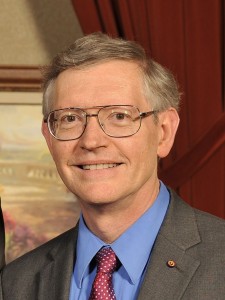RICHA MISHRA*

Credit: Kevin Lowder / Wikimedia Commons
The size of the smallest object that a microscope can resolve is limited to about half the wavelength of the light used because the light would get diffracted—or so it was thought. This limit, thought to be fundamental, was circumvented, a breakthrough for which its pioneers were awarded the Chemistry Nobel Prize in 2014.
One of the three Nobel laureates, W EMoerner of Stanford University, was at IISc on 5 January 2017 to deliver the Morris Travers Lecture, commemorating the contribution of IISc’s first Director.Moerner and colleagues were the first to measure light absorption by a single molecule. They perfected a technique in which a light pulse activates a fraction of fluorescent proteins in the sample to be imaged, with the distance between these ensured to be greater than the diffraction limit. This is then repeated on another subgroup of proteins. When all these images are superimposed, an image of resolution greater than the diffraction limit can be obtained.
Moerner and others have used this and related methods to obtain images, with nanoscale resolution, of molecular machinery. Today, super-resolution microscopy is extensively used in physics, chemistry and the life sciences. One of the variants, single molecule active control microscopy (SMACM), or what Moerner likes to call “smack’em”, is centered on three fundamental concepts. These include spatial resolution, controlled switching between the “on” and “off” states of the molecule as it emits light and gets bleached, and sensitivity to achieve three-dimensional multi-colour super-resolution for materials as well as live cells. Other variants of this technique have been developed by Moerner’s fellow Nobel laureates—Eric Betzig’sPhotoactivated Localization Microscopy (PALM) and Stefan Hell’s Stimulated Emission Depletion Microscopy (STED)—and are largely based on similar principles of controlled photo-switching of fluorescent molecules and extensive mathematical modeling of stochastic emission events. Using a beautiful analogy of fireflies lined up along a branch and randomly glowing at different time intervals to reveal to the onlooker the shape of the tree, Moerner drove home the rationale behind the development of SMACM.
A former research scientist at the IBM Almaden Research Center, California, Moerner emphasized the integral link between the research conducted in an academic environment and its practical extensions in technology and industry. “Keep your eyes open for surprises,” he said. “They might lead to unplanned applications.”
* Richa Mishra is a PhD student at the Centre for Infectious Disease Research


